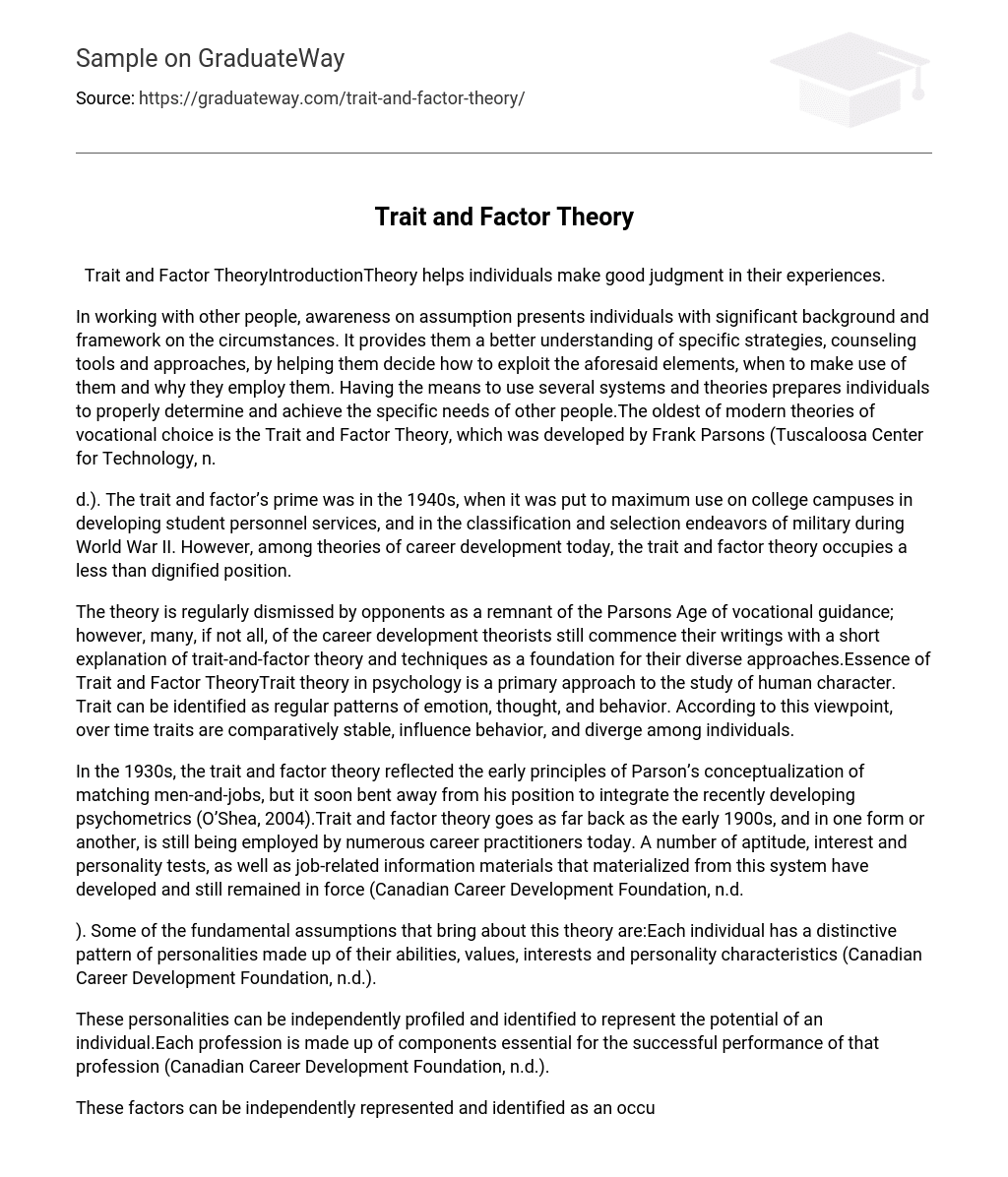Trait and Factor TheoryIntroductionTheory helps individuals make good judgment in their experiences.
In working with other people, awareness on assumption presents individuals with significant background and framework on the circumstances. It provides them a better understanding of specific strategies, counseling tools and approaches, by helping them decide how to exploit the aforesaid elements, when to make use of them and why they employ them. Having the means to use several systems and theories prepares individuals to properly determine and achieve the specific needs of other people.The oldest of modern theories of vocational choice is the Trait and Factor Theory, which was developed by Frank Parsons (Tuscaloosa Center for Technology, n.
d.). The trait and factor’s prime was in the 1940s, when it was put to maximum use on college campuses in developing student personnel services, and in the classification and selection endeavors of military during World War II. However, among theories of career development today, the trait and factor theory occupies a less than dignified position.
The theory is regularly dismissed by opponents as a remnant of the Parsons Age of vocational guidance; however, many, if not all, of the career development theorists still commence their writings with a short explanation of trait-and-factor theory and techniques as a foundation for their diverse approaches.Essence of Trait and Factor TheoryTrait theory in psychology is a primary approach to the study of human character. Trait can be identified as regular patterns of emotion, thought, and behavior. According to this viewpoint, over time traits are comparatively stable, influence behavior, and diverge among individuals.
In the 1930s, the trait and factor theory reflected the early principles of Parson’s conceptualization of matching men-and-jobs, but it soon bent away from his position to integrate the recently developing psychometrics (O’Shea, 2004).Trait and factor theory goes as far back as the early 1900s, and in one form or another, is still being employed by numerous career practitioners today. A number of aptitude, interest and personality tests, as well as job-related information materials that materialized from this system have developed and still remained in force (Canadian Career Development Foundation, n.d.
). Some of the fundamental assumptions that bring about this theory are:Each individual has a distinctive pattern of personalities made up of their abilities, values, interests and personality characteristics (Canadian Career Development Foundation, n.d.).
These personalities can be independently profiled and identified to represent the potential of an individual.Each profession is made up of components essential for the successful performance of that profession (Canadian Career Development Foundation, n.d.).
These factors can be independently represented and identified as an occupational profile.It is not impossible to identify a match or fit between job factors and individual traits by means of a simple problem-solving and decision making procedure.The closer the match between job factors and personal traits the greater the probability for successful job satisfaction and performance.The trait-factor system is concerned with every person’s total development across their environments and life stages.
The immediate objective of the theory is to assist the client to begin applying coherent problem-solving skills for efficient decision making through the discontinuance of nonproductive and irrational behaving and thinking. The continuing objective, on the other hand, is to supply the client with decision-making skills that are jointly devised by society and the client.Today, the impact of the theory has deteriorated to the point that it is downgraded to career counseling books, where it is generally viewed as having no more than historical importance. Despite the fact that in the last 30 years in the academic literature, the theory has not obtained a good deal of journalist acknowledgements, the reality is that the majority rehabilitation, vocational, and school counselors still perform a trait and factor system in some form.
Further, many of the personality, aptitude, and occupational information and interest tests materials devised by the experts have increasingly evolved and continued to be applied at present. In addition, the trait and factor approach is commendably appropriate to computer-therapist-client interaction with computer aided instruction, such as SIGI PLUS, DISCOVER and, other computer aided career guidance program which, regardless of any therapists’ personal opinion, is here to stay and whose purpose will only get bigger.ConclusionTrait and factor theory closely adheres to the doctrines of scientific decision making and problem solving. The theory evidently explains that career choice varies in view of the fact that people vary with reference to traits, and that every person has a distinctive pattern of traits that they exceptionally carry out in work to make the most of out of them.
Philosophically, the trait and factor career counseling has always had a strong commitment to the distinctiveness of the individual. It is essentially believed that there is an ideal career for every person, and that individuals are naturally interested in work that matches their individual traits and competencies. Up to now, many experts still believe that trait and factor theory is still exceptionally logical in view of the fact that it is uncomplicated to understand, and it fits well with other modern theories of career alternative. ReferencesCanadian Career Development Foundation.
(n.d.). Big Picture View of Career Development Theory.
Retrieved February 23, 2009, from http://www.ccdf.ca/ccdf/NewCoach/english/ccoache/e4a_bp_theory.htmO’Shea, A.
J. (2004, November 8). In defense of trait-and-factor theory. Springer Link.
Retrieved February 23, 2009, from http://www.springerlink.com/content/w15132u7377j8504/Tuscaloosa Center for Technology. (n.
d.).Trait-Factor Theory. Retrieved February 23, 2009, from www.tct.tusc.k12.al.us/~dgamble/Powerpoints/Trait-Factor%20Theory.ppt





